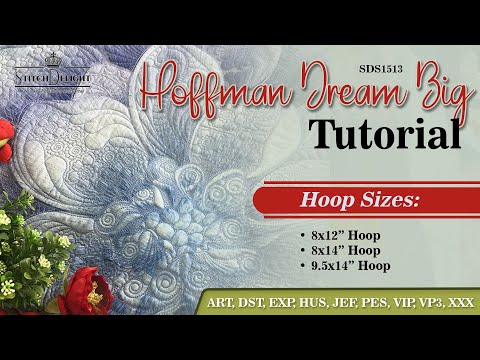Before we can sort our fabric by type, lets learn about different fabrics. Many of you are seasoned sewers and know your fabric by just the feel and look of it. This post is more geared towards newbies OR perhaps if you just want a recap as we often tend to grab the same fabric we are use to.
Machine embroidery has emerged as a popular and versatile technique in the textile industry, allowing intricate designs to be stitched onto various fabrics. Choosing the right fabric is crucial for achieving successful embroidery outcomes. In this blog post, we will explore different fabric types commonly used in machine embroidery, including cotton fabric, poly cotton, stretch fabrics, lycra, scuba stretch knit, fur, faux leather, and netting to name just a few. Each fabric type possesses distinct characteristics and applications within the realm of machine embroidery. If you want more information about a specific type or name of fabric, please feel free to post below.
- Cotton Fabric: Cotton fabric is a natural fiber widely cherished for its breathability, comfort, and durability. It serves as a popular choice for machine embroidery due to its ease of stitching and ability to hold intricate designs. Cotton fabric is commonly used for creating personalized garments, kitchen linens, and home décor items through machine embroidery techniques. Its absorbent nature makes it suitable for monogramming towels and embellishing t-shirts. This is also the go-to fabric for most quilts, although mixed media quilts using different fabrics have proven to gain popularity overt he past years. I made these totally in the hoop oven gloves using cotton fabric, making them durable yet so pretty
- Poly Cotton: Poly cotton blends combine the benefits of natural cotton fibers with synthetic polyester fibers. This fabric type exhibits enhanced durability, wrinkle resistance, and color retention, making it a favored choice for machine embroidery projects that require long-lasting and low-maintenance results. Poly cotton fabrics are frequently utilized for embroidering corporate logos on uniforms, promotional apparel, and household textiles. This is also a much more affordable fabric for quilting then 100% cottons. Poly cotton have such nice bright color, making that my go to for kids projects, like these applique trucks on this quilt - pillows was made using fleece
- Stretch Fabrics: Stretch fabrics, such as jersey or spandex blends, are known for their excellent elasticity and flexibility. These fabrics can stretch in multiple directions, allowing for comfortable and form-fitting garments. In machine embroidery, stretch fabrics are commonly used for embellishing activewear, dance costumes, swimwear, and sportswear, where the embroidery needs to withstand frequent movements and stretching. Although now-a days, stretch fabric can be used in so many ways, you get a almost trapunto feel and look to a quilt style design, especially when combined with different thickness of batting
- Lycra: Lycra, also known as elastane or spandex, is a synthetic fiber renowned for its exceptional elasticity. This fabric type is extensively utilized in machine embroidery projects where stretchability and recovery are paramount. Lycra is commonly employed in the production of performance sportswear, dance costumes, and undergarments. Embroidering on Lycra requires specialized techniques to ensure the design accommodates the fabric's stretch and recovery properties. On this equestrian quilt I used lycra for the front with batting under and 100% cotton for the back, its such a light weight quilt
- Scuba Stretch Knit: Scuba stretch knit fabric is a double-knit fabric made from polyester and spandex. It possesses a smooth texture and substantial body, allowing it to hold structured shapes well. In machine embroidery, scuba stretch knit is frequently chosen dimensional embroidery. The fabric's resilience and smooth surface provide a stable base for intricate embroidery patterns. Scuba stretch knit is also available in several thickness, so experiment and find your favorite. This fabric prints well and comes in a vast array of prints and colors. I used scuba on this pillow I made with the leaves and just look at that dimension you can obtain
- Fur: Fur fabrics, whether natural or synthetic, add a luxurious and textural element to machine embroidery projects. While embroidering on fur can be challenging due to the fabric's pile, proper stabilization techniques and suitable digitized designs can achieve stunning results. Fur is often incorporated in decorative elements of garments, accessories like handbags, and home décor items to add a touch of elegance and sophistication, and do not forget all those in the hoop soft toys. These owls were made using fur for the back and fleece for the front sections
-
Fleece fabric is a soft, warm, and versatile material commonly used in a variety of applications, including clothing, blankets, and accessories. It is known for its insulating properties and ability to provide comfort in cold weather. There are several types of fleece fabric available, each with its own distinct characteristics. Let's explore some of the most popular types of fleece fabric - Fleece is probably the most used fabric to make in the hoop soft toys, and works well for many in the hoop projects.
- Polar Fleece: Polar fleece is one of the most common types of fleece fabric. It is a lightweight, synthetic fabric made from polyester. Polar fleece is known for its excellent insulation, quick-drying properties, and soft texture. It is often used for making jackets, sweatshirts, hats, and blankets. We made these adorable babies using fleece.
- Microfleece: Microfleece is a lightweight and finely-knit fleece fabric that offers a soft and cozy feel. It is made from polyester fibers and provides good insulation while remaining breathable. Microfleece is commonly used in activewear, base layers, pajamas, and baby clothing due to its moisture-wicking properties and comfortable fit.

- Sherpa Fleece: Sherpa fleece, also known as faux shearling, features a thick and fluffy pile on one side, resembling the texture of sheepskin. It provides excellent warmth and a plush feel. Sherpa fleece is often used for making blankets, jackets, vests, and lining materials in footwear and accessories. Sherpa, Coral and Minky can all be used for the top section of Christmas Stockings, where you need that extra bulk and fluff.

- Coral Fleece: Coral fleece, also referred to as minky or plush fleece, is a super-soft and velvety fabric. It has a longer and denser pile compared to other fleece types, giving it a luxurious feel. Coral fleece is commonly used for baby blankets, robes, stuffed toys, and home decor items.

- Anti-Pill Fleece: Anti-pill fleece is designed to resist the formation of small fabric pills, ensuring the fabric maintains a smooth and pristine appearance even after multiple washes and prolonged use. It is a durable option for blankets, clothing, and accessories, where maintaining a clean and neat appearance is desired.
- Sweatshirt Fleece: Sweatshirt fleece, also known as brushed-back fleece or Tracksuiting, is a medium-weight fabric that resembles the traditional fleece used in sweatshirts. It has a smooth outer surface and a brushed interior for added warmth and comfort. Sweatshirt fleece is commonly used for making sweatshirts, hoodies, sweatpants, and casual outerwear.
- Waffle Fleece: Waffle fleece, as the name suggests, features a textured waffle-like pattern on the fabric surface. It is lightweight, breathable, and has good moisture-wicking properties. Waffle fleece is often used for thermal underwear, base layers, and lightweight jackets. This is also a excellent choice for baby blankets and makes the most stunning soft toys, like these bunnies we done totally in te hoop
- Faux Leather: Faux leather, also known as synthetic leather or pleather, is a fabric designed to mimic the look and feel of genuine leather. It is a popular choice for machine embroidery due to its durability and versatility. Faux leather is commonly embroidered to create decorative patches, appliques, and labels on various products, including jackets, bags, wallets, and shoes. Faux leather comes in a vast array of colors and prints, metallic and even glitter types, and extremely popular for making handbags or zipper pouches and key fobs off course. Here we used some faux leather in our camera bag we made a few years back
- Netting: Netting, a sheer fabric with an open and mesh-like structure, adds a delicate and ethereal touch to machine embroidery projects. It is commonly used as an overlay or accent fabric to enhance the visual appeal of garments, veils, and wedding and makes excellent food nets. Netting can also be used to give interesting look and feel to a design, larger holes can add dimension or be part of a specific theme. Similar to this suede punched fabric I used on the fish from The Lets Go Fish Quilt set - Be creative and playful with fabrics to create something unique.


I have covered just a few different fabric types here to get you excited in trying out new fabrics. Explore and be daring and you will be amazed at what you can create - you can transform even the simplest of designs into something of extraordinary beauty with the correct fabric.
Now although we all have limited space and not very often A LOT of each type of fabric, here are some guidelines as to how what type of fabric should be sorted. Remember sorted fabrics makes it easier to plan a project, and if its easier its more fun and it often shows in the end result.
Proper storage of different types of fabric is crucial to maintain their quality, prevent damage, and make them easily accessible for future use. When sorting fabrics by type, consider the following best practices for storage:
-
Cotton Fabric and Poly Cotton: Cotton fabric should be stored in a cool, dry place away from direct sunlight to avoid color fading. Folding cotton fabrics neatly and placing them in acid-free tissue paper or fabric storage bins helps prevent creasing and dust accumulation.
-
Stretch Fabrics: Stretch fabrics, such as jersey or spandex blends, should be stored flat or rolled to preserve their elasticity. Folding may cause permanent creases.
-
Fur: Fur fabrics should be stored in a cool and dark place to prevent drying out or discoloration. Store fur garments in breathable fabric bags or wrap them in acid-free tissue paper to maintain their texture. Avoid using plastic bags, as they can trap moisture and damage the fur.
-
Faux Leather: Faux leather fabric should be stored in a dry, cool area away from direct sunlight to prevent cracking or peeling. . Avoid folding or compressing faux leather for long periods, as it may lead to permanent creases. Rather roll them up - I make use of tin foil cart board tubes to roll up my leather.
-
Netting: Netting fabric should be stored loosely to avoid snagging. Folding netting gently and placing it in fabric storage bins or hanging it in a cool, dry area will help maintain its delicate structure. Consider covering netting with a breathable fabric to protect it from dust and damage.
I hope this blog post gave you some more information on fabric types and perhaps inspire you
On our next installment of our Makeover Extravaganza we will look at stabilizer, different types, their uses and how to store them - this is not to be missed as stabilizer forms the foundation of any embroidery design and learning what to use when is crucial in the end result.


























2 comments
Sue Bierly
I like the ability to click a link to get to the blog. Great information on storage of fabric. I’ve been sewing/embroidering many years and still learning. Thank you to Stitch Delight and readers for the helpful ideas to make sewing fun and professional.
Wilna Geel
I love using Chintz for embroidered items. It is sturdy with a bit of gloss. Just difficult to get hold of as it is considered as “old” fabric.